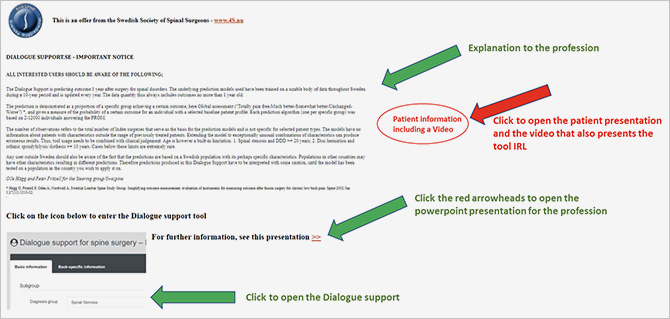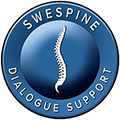The Dialogue Support
Information for patients and other non-professional visitors, using the ‘The Dialogue Support’
Dear Visitor,
The programme called “The Dialogue Support”, has been developed to be an aid when discussing and deciding on surgery for common diseases of the low back and neck.
The support is based on, today October 2020, approximately 140 000 Swedish patients (increasing with approximately 10 000 every year) having gone through a surgical procedure for those diseases. Patients are registered in the Swedish National Quality Register (Swespine), where they have answered questionnaires before the operation and 1 year after, providing data to document outcome, i.e. if pain and function were improved or not.
No individuals are completely alike, including of course patients going through surgery for back or neck problems. We are of different age, height, and weight. We have varying mental state, social state, and physical capacity. Some of us smoke. As patients with back or neck problems we have different intensity of both back and leg pain, or neck and arm pain, and we have had pain for varying periods of time. We may also have other diseases that could influence quality of life.
This means that not only the diagnosis as such, for example a disc herniation or a spinal stenosis, and the surgical removal of it, determine the outcome of an operation. Many individual factors also influence the degree of improvement. This is the reason why it is difficult for a surgeon to state with certainty how much an operation will benefit you or not. And, which is important to consider, all surgical procedures include a possible risk of not getting better, and of complications.
Swespine includes data on the individual aspects mentioned above, and many more. By statistical analysis of the whole database it is possible to weight the importance of the individual aspects for the outcome after surgery. This knowledge reduces the uncertainty in predicting outcome and serves as the basis and function of the Dialogue Support that you are about to enter.
One important consideration before you continue: the outcome presented in the Dialogue Support is still a prediction based on statistics. It is NOT a certain fact! The actual outcome may differ from the prediction, why it is important that you discuss with your spine surgeon before deciding on surgery.
The programme called “The Dialogue Support”, has been developed to be an aid when discussing and deciding on surgery for common diseases of the low back and neck.
The support is based on, today October 2020, approximately 140 000 Swedish patients (increasing with approximately 10 000 every year) having gone through a surgical procedure for those diseases. Patients are registered in the Swedish National Quality Register (Swespine), where they have answered questionnaires before the operation and 1 year after, providing data to document outcome, i.e. if pain and function were improved or not.
No individuals are completely alike, including of course patients going through surgery for back or neck problems. We are of different age, height, and weight. We have varying mental state, social state, and physical capacity. Some of us smoke. As patients with back or neck problems we have different intensity of both back and leg pain, or neck and arm pain, and we have had pain for varying periods of time. We may also have other diseases that could influence quality of life.
This means that not only the diagnosis as such, for example a disc herniation or a spinal stenosis, and the surgical removal of it, determine the outcome of an operation. Many individual factors also influence the degree of improvement. This is the reason why it is difficult for a surgeon to state with certainty how much an operation will benefit you or not. And, which is important to consider, all surgical procedures include a possible risk of not getting better, and of complications.
Swespine includes data on the individual aspects mentioned above, and many more. By statistical analysis of the whole database it is possible to weight the importance of the individual aspects for the outcome after surgery. This knowledge reduces the uncertainty in predicting outcome and serves as the basis and function of the Dialogue Support that you are about to enter.
One important consideration before you continue: the outcome presented in the Dialogue Support is still a prediction based on statistics. It is NOT a certain fact! The actual outcome may differ from the prediction, why it is important that you discuss with your spine surgeon before deciding on surgery.
Once you press the blue icon, you see information to the profession, including a PowerPoint presentation (if you press two red arrow heads at the bottom right). To see this text, you have chosen to click on “Patient information including a video”.
Now press the square icon at the bottom left and you will open the support.
The important thing is that you enter all your personal characteristics correctly in the left column. Start with “Basic information” which appears automatically. Begin with “Diagnosis group”. There are four alternatives: Disc herniation (Lumbar disc herniation), Spinal stenosis (Lumbar spinal stenosis = narrowing of the spinal canal), Degenerative disc disease (Chronic low back pain), and Rhizopathy neck (Cervical disc herniation or stenosis).
Then continue downwards and fill in all questions on this side (the last question is Comorbidity). Quality of life (EQ-5D) may be difficult, but you can leave that question if you do not know the answer. For example, use 0,3.
When you have done this, press “Back-specific information” at the top of the page and fill in data, again in the left column. For functional impairment, if you do not know this, you could use for example 45.
That is all you must do.
Now you can concentrate on the right side of the screen, where you will find the circular “pie diagram” in different colors, the “Results = Outcome”. At the top you find two percentage numbers: “Proportions of satisfied patients” and “Proportion with successful outcome”, and also the “Expected length of stay” (days).
The percentage number to the left is the proportion of patients in Swespine having approximately the same characteristics as you at the time of surgery, and who report that they are satisfied with the outcome.
The percentage number in the middle is the proportion of patients having approximately the same characteristics as you, who consider the outcome successful. Successful means that pain has disappeared or is much improved.
The number to the right is the expected length of stay in hospital (in Sweden, these figures may differ from country to country) after surgery under the same conditions as above.
When you look at the circular “pie diagram” you see a more detailed description of the predicted outcome for the whole group of patients with similar characteristics as yours. Dark green and light green added = “success”. You will find that a small “piece” shows the proportion of the patients whose pain was unchanged (orange) and another small “piece” showing those who report worse pain after surgery (red). The yellow “piece” reflects those who report “somewhat better”, which is considered to be too uncertain to be included in the “success”-group.
The results presented in the Dialogue Support give you an idea of what you could expect if you chose to have an operation.
But you must keep in mind that the results are PREDICTIONS, PROBABILITIES, NOT FACTS! And, that your physician may have additional information that is relevant to consider in your case.
You must also be aware that the results are based on analysis of Swedish citizens. General conditions in your own country may be different, and this could influence outcome. However, all included, these predictions are based on reports from many thousands of patients, making the predictions relevant to take into consideration. You can find the actual numbers by choosing the little circular grey symbol at the far-right bottom end of the screen;
Now press the square icon at the bottom left and you will open the support.
The important thing is that you enter all your personal characteristics correctly in the left column. Start with “Basic information” which appears automatically. Begin with “Diagnosis group”. There are four alternatives: Disc herniation (Lumbar disc herniation), Spinal stenosis (Lumbar spinal stenosis = narrowing of the spinal canal), Degenerative disc disease (Chronic low back pain), and Rhizopathy neck (Cervical disc herniation or stenosis).
Then continue downwards and fill in all questions on this side (the last question is Comorbidity). Quality of life (EQ-5D) may be difficult, but you can leave that question if you do not know the answer. For example, use 0,3.
When you have done this, press “Back-specific information” at the top of the page and fill in data, again in the left column. For functional impairment, if you do not know this, you could use for example 45.
That is all you must do.
Now you can concentrate on the right side of the screen, where you will find the circular “pie diagram” in different colors, the “Results = Outcome”. At the top you find two percentage numbers: “Proportions of satisfied patients” and “Proportion with successful outcome”, and also the “Expected length of stay” (days).
The percentage number to the left is the proportion of patients in Swespine having approximately the same characteristics as you at the time of surgery, and who report that they are satisfied with the outcome.
The percentage number in the middle is the proportion of patients having approximately the same characteristics as you, who consider the outcome successful. Successful means that pain has disappeared or is much improved.
The number to the right is the expected length of stay in hospital (in Sweden, these figures may differ from country to country) after surgery under the same conditions as above.
When you look at the circular “pie diagram” you see a more detailed description of the predicted outcome for the whole group of patients with similar characteristics as yours. Dark green and light green added = “success”. You will find that a small “piece” shows the proportion of the patients whose pain was unchanged (orange) and another small “piece” showing those who report worse pain after surgery (red). The yellow “piece” reflects those who report “somewhat better”, which is considered to be too uncertain to be included in the “success”-group.
The results presented in the Dialogue Support give you an idea of what you could expect if you chose to have an operation.
But you must keep in mind that the results are PREDICTIONS, PROBABILITIES, NOT FACTS! And, that your physician may have additional information that is relevant to consider in your case.
You must also be aware that the results are based on analysis of Swedish citizens. General conditions in your own country may be different, and this could influence outcome. However, all included, these predictions are based on reports from many thousands of patients, making the predictions relevant to take into consideration. You can find the actual numbers by choosing the little circular grey symbol at the far-right bottom end of the screen;

Finally, we again strongly advise you to discuss the demonstrated results with your physician, so you know you have not misunderstood anything.
October 2020
EUROSPINE steering board; Everard Munting and Tim Pigott
Swespine steering group/Swespine society of spinal surgeons;
Peter Fritzell and Olle Hägg
October 2020
EUROSPINE steering board; Everard Munting and Tim Pigott
Swespine steering group/Swespine society of spinal surgeons;
Peter Fritzell and Olle Hägg
The Patient Line website offers information for patients with spinal conditions:
Sciatica, back pain, spinal stenosis, disc herniation, scoliosis and many other spine conditions explained in a clear reliable, and trustworthy way. Not for profit EUROSPINE experts are here to help patients and their families understand what may be worrying them.
EUROSPINE is a society of spine specialists of various disciplines with a large knowledge of spine pathologies. All well-known and accepted treatment modalities for spine pathologies are represented by the members of the society. However, the Society cannot accept any responsibility for the use of the information provided; the user and their health care professionals must retain responsibility for their health care management.



